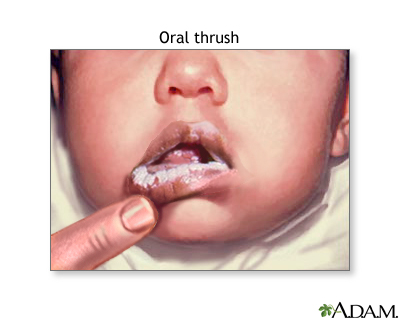Thrush is a yeast infection of the tongue and lining of the mouth.
Causes
Certain germs normally live in our bodies. These include bacteria and fungi. While most germs are harmless, some can cause infection under certain conditions.
Thrush occurs in children and adults when conditions permit too much growth of a fungus called Candida in your mouth. A small amount of this fungus normally lives in your mouth. It is most often kept in check by your immune system and other germs that also live in your mouth.
When your immune system is weak or when normal bacteria die, too much of the fungus can overgrow and cause thrush.
You are more likely to get thrush if you have one of the following:
- You are in poor health.
- You are very old. Young babies are also more likely to develop thrush.
- You have HIV or AIDS.
- You are receiving chemotherapy or medicines that weaken the immune system.
- You are taking steroid medicine, including some inhalers for asthma and chronic obstructive pulmonary disease (COPD).
- You have diabetes mellitus and your blood sugar is high.
- You take antibiotics. Antibiotics kill some of the healthy bacteria that prevent Candida from growing too much.
- Your dentures do not fit well.
Candida can also cause yeast infections in the vagina.
Thrush in newborns is somewhat common and easy to treat.
Symptoms
Symptoms of thrush include:
- White, velvety sores in the mouth and on the tongue
- Some bleeding when you brush your teeth or scrape the sores
- Pain when swallowing

Exams and Tests
Your health care provider or dentist can usually diagnose thrush by looking at your mouth and tongue. The sores are easy to recognize.
To confirm you have thrush, your provider may:
- Take a sample of a mouth sore by gently scraping it.
- Examine mouth scrapings under a microscope.
In severe cases, thrush can grow in your esophagus as well. The esophagus is the tube that connects your mouth to your stomach. If this occurs or is suspected, your provider may:
- Take a throat culture to see what germs are causing your thrush.
- Examine your esophagus and stomach with a flexible, lighted scope with a camera on the end.
Treatment
If you get mild thrush after taking antibiotics, eat yogurt or take over-the-counter acidophilus pills. This may help restore a healthy balance of germs in your mouth.
For a more severe case of thrush, your provider may prescribe:
- Antifungal mouthwash (nystatin).
- Lozenges (clotrimazole).
- Antifungal medicines taken as a pill or syrup, these medicines include fluconazole (Diflucan) or itraconazole (Sporanox).
Outlook (Prognosis)
Oral thrush can be cured. However, if your immune system is weak, thrush may come back or cause more serious problems.
Possible Complications
If your immune system is weakened, Candida can spread throughout your body, causing a serious infection.
This infection might affect your:
- Brain (meningitis)
- Esophagus (esophagitis)
- Eyes (endophthalmitis)
- Heart (endocarditis)
- Joints (arthritis)
When to Contact a Medical Professional
Contact your provider if:
- You have thrush-like sores.
- You have pain or difficulty swallowing.
- You have symptoms of thrush and you are HIV positive, receiving chemotherapy, or you take medicines to suppress your immune system.
Prevention
If you get thrush often, your provider may recommend taking antifungal medicine on a regular basis to keep thrush from coming back.
If you have diabetes mellitus, you can help prevent thrush by keeping good control of your blood sugar levels.
Alternative Names
Candidiasis - oral; Oral thrush; Fungal infection - mouth; Candida - oral
References
Ericson JE, Benjamin DK. Candida. In: Kliegman RM, St. Geme JW, Blum NJ, et al, eds. Nelson Textbook of Pediatrics. 22nd ed. Philadelphia, PA: Elsevier; 2025:chap 280.
Jordan RC. Diseases of the mouth and salivary glands. In: Goldman L, Cooney KA, eds. Goldman-Cecil Medicine. 27th ed. Philadelphia, PA: Elsevier; 2024:chap 393.
Lionakis MS, Edwards JE. Candida species. In: Blaser MJ, Cohen JI, Holland SM, et al, eds. Mandell, Douglas, and Bennett's Principles and Practice of Infectious Diseases. 10th ed. Philadelphia, PA: Elsevier; 2026:chap 262.
Review Date 8/5/2025
Updated by: Jatin M. Vyas, MD, PhD, Roy and Diana Vagelos Professor in Medicine, Columbia University Vagelos College of Physicians and Surgeons, Division of Infectious Diseases, Department of Medicine, New York, NY. Also reviewed by David C. Dugdale, MD, Medical Director, Brenda Conaway, Editorial Director, and the A.D.A.M. Editorial team.





